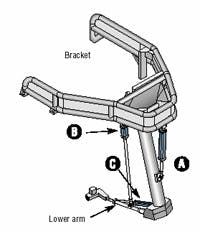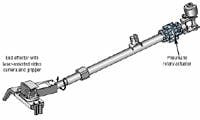Pneumatic milking robot gives dairy farmers a vacation
Equipment for Voluntary Milking System includes multi-purpose arm in vertical rest position and pneumatic cylinders that manipulate arm at lower right.
Lower arm's end effector supports housing for video camera and lasers, as well as gripper. Rubber cap over plastic cover of housing protects interior electronics.
The multi-purpose arm consists of a fixed bracket, mounted on the frame of the milking station, that supports the upper arm, which in turn holds the lower arm.
Lower arm's rotary actuator and tilting end effector manipulate video camera and gripper to search for and locate both cow and milking accessories.
Dairy farming is probably most labor-intensive agricultural endeavor. Cows have to be milked every day — three times for optimum production — year-round. Equipment has replaced manual procedures on most farms, but someone still has to prepare each animal and then connect disconnect the milking equipment. Just getting the cows to the equipment area can be a chore.
Engineers at DeLaval International AB, Tumba, Sweden, set out to remove the human factor as much as possible in their computer-controlled, robotic Voluntary Milking System (VMS). One ambitious goal was to make the experience so comfortable and enjoyable for the cows that each animal would return to the milking station voluntarily — whenever her own physiology told her that the time was right. The result would be healthier, happier cows and improved quality milk.
The system starts by measuring each cow's contours, storing that data in the central computer, and putting an identity tag around the animal's neck. If the cow tries to enter the milking stall adjacent to the VMS, the computer identifies her and checks for the last time she was milked — to ensure that she is not milked too often. If the computer determines that the cow is ready to be milked, the stall is opened. The computer now calls up this cow's dimensions, adjusts the stall's to her length, and dispenses to a manger to distract milking. The dimensional information also is fed to pneumatically powered purpose robotic arm that seven basic operations:
- retrieving the teat-preparation its home position
- holding and moving the cup at each teat for cleaning, then returning cup to home
- removing the teat cups — the actual milking — from their magazine
- locating and recognizing the cow's udder and teats
- attaching the milking cups to the teats
- holding the milk tubes movements by the the cow do not change the cups' alignment
- and treating the teats after the milking operation is complete.
The arm uses a video camera and two adjacent lasers to assist in each of these operations. The camera receives reflected laser beams and converts them into images. The software at the milking station then interprets the images.
Cylinders for positioning
Guided by the camera, three pneumatic cylinders controlled by proportional directional valves generate all the arm motions. They quickly extend the arm the exact distance to reach the cow's udders, attach the teat cups, and start milking. Each cylinder moves the multi-purpose arm in a specific direction: cylinder A moves the upper and lower arms along the width of the milking station; cylinder B lifts the lower arm up or down; and cylinder c moves the lower arm along the length of the milking station. The multi-purpose arm also has three positional sensors. The software that controls the arm uses readings from these sensors to establish its position.
When a cow enters the station, a plate behind her swings forward — toward the center of the station — and rests against the cow's back legs. A sensor is connected to the rear plate, and its signals enable the arm to follow a cow's movements in the station. This rear sensor monitors the motion of the rear plate when the cow moves forward or backwards. The signals are sent to the software controlling the arm so the arm can follow any movements. This assures reliable attachment of the milking cup.
The Norgren cylinders, which actually carry out the milking process have to be both gentle — to maintain the cow's comfort — and tough — to cope with the number of cycles demanded of them. In addition, they have to deal with an aggressive environment that includes ammonia, water, and cow dirt.
These low-friction, double-acting actuators have stainless-steel piston rods, anodized-aluminum profiled barrels, and anodized cast-aluminum end caps. They have magnetic pistons to feed position information back to the computer, and are fitted with 2-component polyurethane rod seals to exclude contaminants.
Camera and gripper
The lower arm is fitted with a rotary actuator and an end effector, which carries the gripper and the camera/laser housing. (The rotary actuator, end-effector tilt, and gripper are driven by compressed air.) The rotary actuator can swivel the axis — between the two end positions: one where the camera house points downwards, the other where the camera house points upwards. The outer end of the end effector can be tilted between two positions in order to widen the search area for the camera. (Sensors monitor all of the end positions.)
The gripper closes around the handle of a cup when it removes one from the magazine. Sensors check whether the gripper is open or not, and if it is holding a cup. The speed of rotation, tilting angle, and gripping force can be adjusted.
The multi-purpose arm has builtin-safety functions that are intended to prevent injuries to cows and personnel, and to avoid damage to other parts of the milking station. One important function that is checked carefully is the velocity of the arm. If the arm makes a movement in any direction with a velocity that exceeds a predetermined value, the computer immediately shuts off the air supply to the arm.
Conclusion
The Voluntary Milking System has been used by farmers across Western Europe, Scandinavia, Japan, and Canada, since June 2000. The rest of the world is DeLaval's goal.
Click here to see a video of Delaval's Voluntary Milking System.





